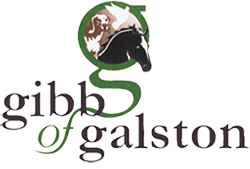The story of Gibb of Galston
The Gibb family has farmed the land at Threepwood, since 1935. James Gibb (Jimmy) has been farming all his life, learning alongside, and taking over from, his father James Gibb senior.
Diversification
From the early 1970’s to ’87 Threepwood was an intensive dairy farm with 145 cows.
Forward thinker Jimmy, didn’t believe that intensive methods were the future for his business. The soil quality was being depleted and the quality of produce was being compromised. A believer in traditional farming practices, Jimmy set out to improve soil structure and fertility by means of crop rotation. The outcome being grass and crops less reliant on purchased fertilizer.
During this time, the economics of traditional farming was not viable. Jimmy had to look at ways to diversify in order to provide additional income to sustain the traditional farming methods.
Establishing Gibb of Galston
By looking at the resources to hand: home grown grain, straw, hay and farm equipment, Jimmy hit on the idea of creating an animal feed trade. ‘Gibb of Galston’ was established as the brand name for James Gibb Animal Feeds Ltd. Today, this business is successfully managed by Jimmy’s son, William.
Resting the soil
By the late 1980’s the animal feeds business was well established. Jimmy decided to stop dairy farming and concentrate on sheep and beef farming. A flock of North County Cheviot ewes was established. This move rested the soil and gave the grass and clover a chance to flourish.
The turn of the century!
In 1999, Jimmy became involved in the Countryside Premium Scheme. This initiative led to:
- the creation and establishment of new hedgerows on the farm
- fencing along some of the banks of Burn Anne, to encourage a natural water margin biodiversity
- construction of a wildlife pond and wetland area
- hay and silage fields uncut until mid July, to allow ground nesting birds to nest and rear their young undisturbed
- the establishment of a 2 acre plot of rough grazing below Target Wood, allowing wild plants to flourish during spring and summer, and late grazing encouraging self seeding.
Loving the land
Encouraging wildlife
In 2004 Jimmy entered into the Rural Stewardship Scheme, which led to more hedge planting (a staggering 2600m), the fencing off of ditches and the building of a bigger wildlife pond. The scheme led to the creation of wildlife corridors, or animal highways, to ensure that animals can travel throughout the farm whilst being sheltered in their natural habitat.
Planting trees
In 2005 a, Forestry Commission, funded scheme resulted in tree planting and public access. Around 9000 indigenous trees have been planted up the west side of Burn Anne, Target Wood and other areas. Over 3.5km of public footpath has been opened which leads you along Burn Anne, up to Target Wood and down the west of Threepwood.
Slow food
In 2008, Jimmy purchased neighbouring Middlethird Farm, creating a farming operation totaling 425 acres. The land is stocked with cattle and sheep supplying good quality slow growing beef and lamb. Running on a low input system relying on clover to supplement the grass, this creates natural growing grass, kale and silage for winter feeding. This also reduces the reliance on man-made fertilisers and purchased feeds.
In 2018, the cattle were sold in a bid to reduce carbon footprint and alleviate the environmental damage and expense of using heavy machinery. Jimmy now focuses on sheep farming which has lower input, fuel and machinery costs, and a less detrimental effect on the soil. The environmentally friendly practices result in quality wool, which sells all over the world, and succulent and flavourful Ayrshire lamb.
Reclaim, reuse and recycle
Jimmy has an inherent love of the land and is a keen gardener. A true Scot, he hates waste and has always practiced recycling and reclamation. His entrepreneurial spirit has seen him combine these interests, with the result of the creation of another company, Gibb of Galston Timber, Architectural Salvage and Stone (TASS), selling natural and reclaimed landscaping materials and timber from the on site sawmill. You’re welcome to enjoy the gardens at Threepwood Farm, constructed using reclaimed materials that others have discarded.

